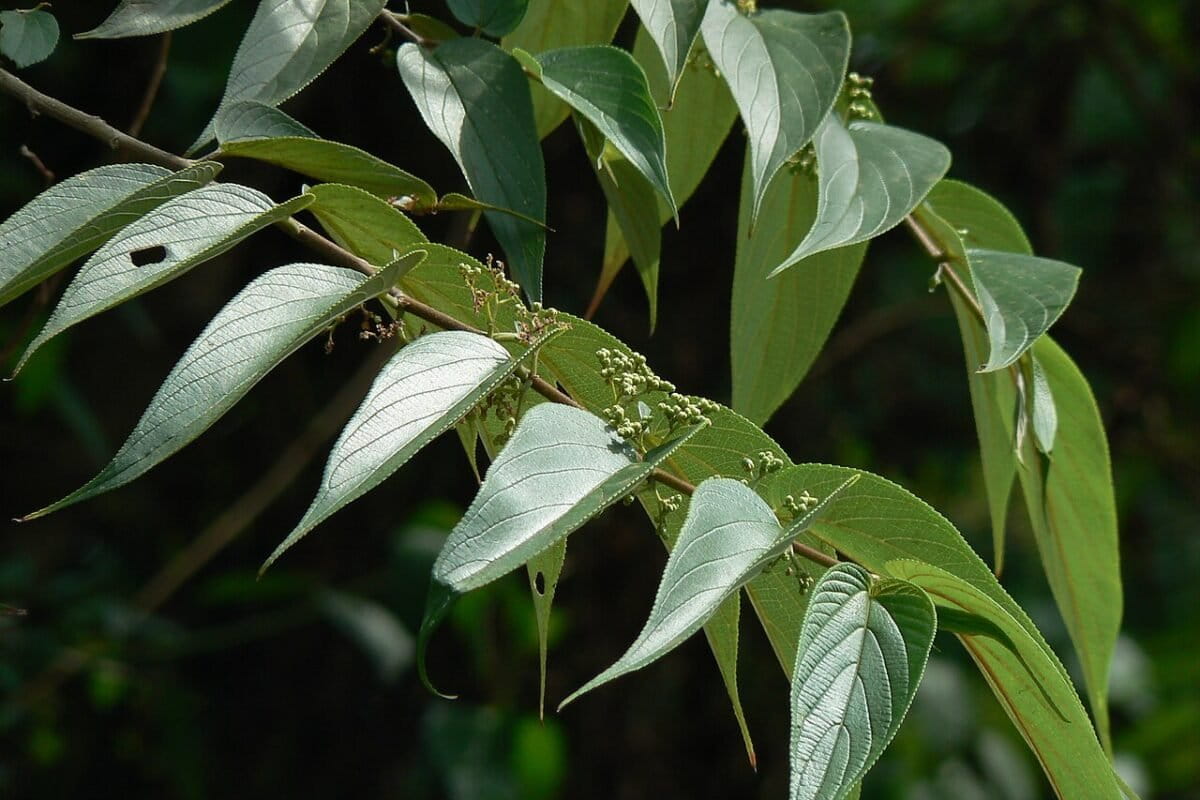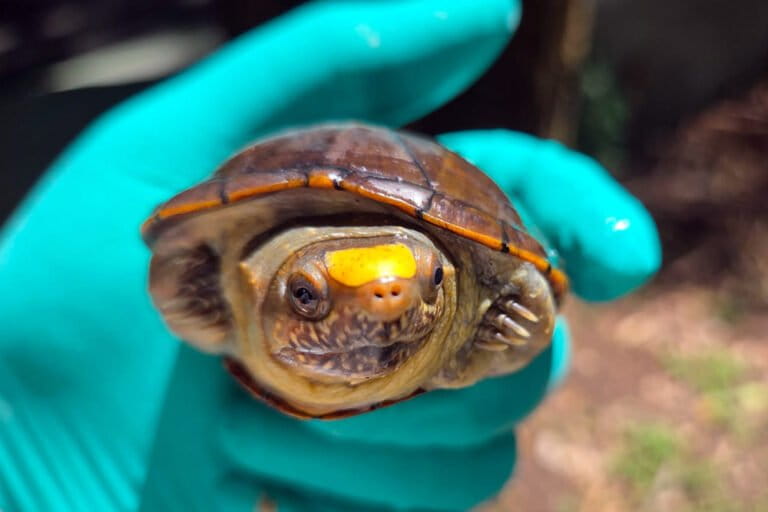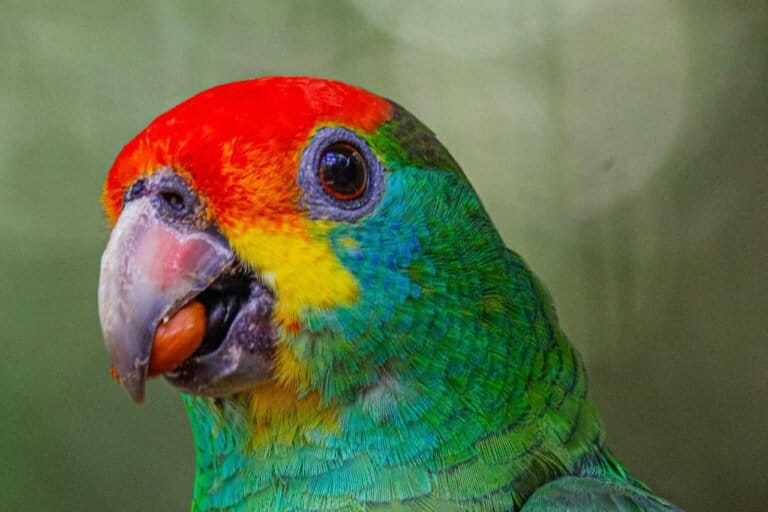Big-fanged bat threatened by dam construction

New bat, Hypsugo dolichodon, showing off its remarkable canines. Photo by: Judith L. Eger.
What big teeth you have, my dear! The better to eat insects with—and make one’s own ecological niche. Scientists have uncovered a new bat with stupendous canines in the rainforests of Lao PDR and Vietnam, aptly naming it Hypsugo dolichodon, or the long-toothed pipistrelle. Describing the new species in ZooTaxa, the researchers say the bat is most closely related to the Chinese pipistrelle (Hypsugo pulveratus), which is found across much of eastern Asia. However, the new species not only sports longer fangs than its relative, but is also bigger altogether.
“The new bat species was trapped by Charles M. Francis and Antonio Guillén in 1997. The conspicuous differences could be seen nearly [on] first sight, but the description of the species awaited until 2014,” lead author, Tamás Görföl with the Hungarian Natural History Museum, told mongabay.com. It took 17 years to describe the new bat because researchers had to gather more evidence and compare specimens, including ones housed in museums around the world. Genetic research also clearly proved the fanged bat was, until now, unknown to science.
But why such impressive fangs?
“The large canines may be important in grabbing prey,” Görföl said. “It may allow the bat to catch larger insects or beetles with harder exoskeleton; this may be the result of niche segregation.”

Another view of a live long-toothed pipistrelle. Photo by: Judith L. Eger.
This means that evolution may have allowed the new species to go after different prey or utilize different habitat than its close relatives, essentially carving out its own ecological niche.
Although the new pipistrelle is found in both Lao PDR (Laos) and Vietnam—including the Dong Amphan National Biodiversity Area in Lao PDR and Cat Tien National Park in Vietnam—it could be imperiled. In fact, one of the areas where the specimen was caught is currently being destroyed by the construction of a dam on the Xe Kaman River in Lao PDR.
“The proposed dam is under construction and the soil works are completely destroying the vegetation around the river,” noted Görföl. “This threatens the new bat species, but it can presumably survive in other areas of its distribution if we stop the deforestation of the tropical landscapes. The species may be cave-dweller, so protection of caves is also important.”
Like most species new-to-science very little is known about the long-toothed pipistrelle. More research, and possible conservation attention, are needed.
Bats are the second most diverse family of mammals (after rodents) with over 1,200 species and counting. Every year, several new species of bat are discovered. Bats play huge ecological roles in the environment including dispersing seeds, keeping insect populations in check, and even pollinating flowers.

The long-toothed pipistrelle. Photo by: Judith L. Eger.
CITATION: GÖRFÖL, TAMÁS, GÁBOR CSORBA, JUDITH L. EGER, NGUYEN TRUONG SON, and CHARLES M. FRANCIS. “Canines make the difference: a new species of Hypsugo (Chiroptera: Vespertilionidae) from Laos and Vietnam.” Zootaxa 3887, no. 2 (2014): 239-250.
Related articles
|
New survey finds surprisingly large population of endangered owl
(12/03/2014) The Anjouan scops owl—an elusive owl found only on its tiny eponymous island—was once considered among the world’s most endangered owls, and even the most threatened birds. However, the first in-depth survey of the owls on the island finds that, in fact, the population is far larger than initially estimated. |
|
Destroyed habitat, fewer resources, Ebola: the many repercussions of Liberia’s deforestation
(10/29/2014) Liberia is one of the last strongholds of intact forest in West Africa. These forests are the home of many unique species of plants and animals, and many Liberians rely on the forests for direct economic benefits. The presence of intact forests may even be important for preventing the future outbreak of disease such as Ebola, which can be transmitted to people from animal vectors displaced by deforestation. |
|
Scientists find temperate bat in the hot tropics of the Western Ghats (photos)
(10/15/2014) The Western Ghats is one of the world’s eight richest biodiversity hotspots. A UNESCO World Heritage site, and also known as the Great Escarpment of India, the Ghats run parallel to India’s west coast. This great ecosystem is home to over 139 mammal species, nearly 50 of which are bats. And now scientists can add a new bat to this list: one that until now had only been documented from temperate regions. |
|
Fragmented forests hurt some bat species, may benefit others
(09/23/2014) Development of roads and other structures disturb large, continuous patches of habitat for wildlife. This habitat fragmentation is one of the biggest contributors to species extinction, as the local ecology and species interactions are altered. A new study finds that leaf-nosed bat abundances in Mexico are closely linked to how sensitive each species is to habitat fragmentation. |
|
Don’t eat or touch bat bushmeat amid worsening Ebola outbreak, UN warns
(07/29/2014) The world’s worst Ebola outbreak was likely begun by a hunter shooting a fruit bat for their dinner or the market, according to the UN. The outbreak has killed over 660 people in six months to date, and recently spread via plane to Nigeria. The disease is particularly deadly with a mortality rate of around 90 percent. |


















